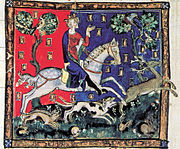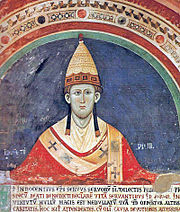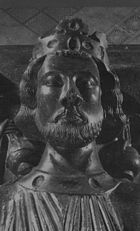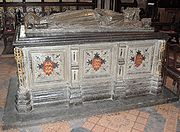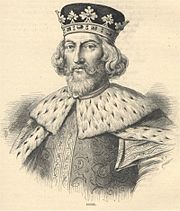
John, King of England
Background to the schools Wikipedia
SOS Children produced this website for schools as well as this video website about Africa. SOS Children works in 45 African countries; can you help a child in Africa?
| John "Lackland" | |
|---|---|
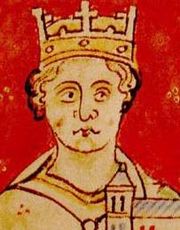 |
|
| John from the Historia Anglorum | |
|
|
|
| Reign | 6 April 1199 – 19 October 1216 |
| Predecessor | Richard I "the Lionheart" |
| Successor | Henry III of England |
| House | House of Plantagenet |
| Father | Henry II "Curtmantle" |
| Mother | Eleanor of Aquitaine |
| Burial | Worcester Cathedral |
John (24 December 1166 – 19 October 1216), King of England, reigned from 6 April 1199 until his death. He acceded to the throne as the younger brother of King Richard I, who died without issue. John was the youngest of five sons of King Henry II of England and Eleanor, Duchess of Aquitaine, and was their second surviving son to ascend the throne; thus, he continued the line of Plantagenet or Angevin kings of England. Prior to his coronation, he was Earl of Cornwall and Gloucester, but this title reverted to the Crown once he became King.
During his lifetime John acquired two epithets. One was "Lackland" (French: Sans Terre), because, as his father's youngest son, he did not inherit land out of his family's holdings, and because as King he lost significant territory to the king of France. The other was "Soft-sword", for his alleged military ineptitude.
Apart from entering popular legend as the enemy of Robin Hood, he is perhaps best-known for having acquiesced —to the barons of English nobility— to seal Magna Carta, a document which limited kingly power in England and which is popularly thought as an early step in the evolution of modern democracy.
Early life
While John was his father's favourite son, as the youngest he could expect no inheritance. His family life was tumultuous, as his older brothers all became involved in rebellions against Henry. His mother, Eleanor, was imprisoned by Henry in 1173, when John was about 7. As a child, John was betrothed to Alais (pronounced 'Alice'), daughter and heiress of Humbert III of Savoy. It was hoped that by this marriage the Angevin dynasty would extend its influence beyond the Alps, because John was promised the inheritance of Savoy, the Piemonte, Maurienne, and the other possessions of Count Humbert. King Henry promised his young son castles in Normandy which had been previously promised to his brother Geoffrey; this promise was for some time a bone of contention between Henry and Geoffrey. Alais made the trip over the Alps and joined Henry's court, but she died before being married. Gerald of Wales relates that King Henry had a curious painting in a chamber of Winchester Castle, depicting an eagle being attacked by three of its chicks, while a fourth chick crouched, waiting for its chance to strike. When asked the meaning of this picture, King Henry said:
- "The four young ones of the eagle are my four sons,... who will not cease persecuting me even unto death. And the youngest, whom I now embrace with such tender affection, will someday afflict me more grievously and perilously than all the others."
Before his accession, John had already acquired a reputation for treachery, having conspired sometimes with and sometimes against his elder brothers, Henry, Richard and Geoffrey. In 1184, John and Richard both claimed that they were the rightful heir to Aquitaine, one of many unfriendly encounters between the two. In 1185, John became the ruler of Ireland, whose people grew to despise him, causing John to leave after only eight months.
Richard's absence
During Richard's absence on the Third Crusade from 1190 to 1194, John attempted to overthrow William Longchamp, the Bishop of Ely and Richard's designated justiciar. This was one of the events that inspired later writers to cast John as the villain in their reworking of the legend of Robin Hood.
John was more popular than Longchamp in London, and in October 1191 the leading citizens of the city opened the gates to him while Longchamp was confined in the tower. John promised the city the right to govern itself as a commune in return for recognition as Richard's heir presumptive. While returning from the Crusade, Richard was captured by Leopold V, Duke of Austria, and handed over to Henry VI, Holy Roman Emperor, who held him for ransom. Meanwhile, John had joined forces with Philip Augustus, King of France, and they sent a letter to Henry asking him to keep Richard away from England for as long as possible, offering payment to keep Richard imprisoned. Henry declined their offer, and once Richard's ransom was paid by his mother Eleanor of Aquitaine (who had to pawn the Crown Jewels of England to do so), he was set free. Upon the release, John pleaded for forgiveness from Richard, who granted it and named him heir presumptive.
Reign
Dispute with Arthur
When Richard died, John did not gain immediate universal recognition as Richard's successor. Some regarded his young nephew, Arthur of Brittany, the son of John's late brother Geoffrey, as the rightful heir. Arthur fought his uncle for the throne, with the support of King Philip II of France. The conflict between Arthur and John had fatal consequences. By the May 1200 Treaty of Le Goulet, Philip recognised John over Arthur, and the two came to terms regarding John's vassalage for Normandy and the Angevin territories, but the peace was ephemeral.
The war upset the barons of Poitou, where John was Count, enough for them to seek redress from the King of France, who was King John's feudal overlord with respect to Poitou and certain other territories on the Continent. In 1202, John was summoned to the French court to answer the Poitevin barons' charges, one of which was his marriage to Isobel of Angouleme, who was already engaged to Guy de Lusignan. Philip Augustus summoned John to his court when the Lusignans pleaded for his help. John refused, and, under feudal law, because of his failure of service to his lord, Philip declared all John's French lands and territories, except Gascony in the southwest, forfeit. The French promptly invaded Normandy; Philip invested Arthur with all the fiefs of which he had deprived John, except for Normandy, and betrothed him to his daughter Marie.
Needing to supply a war across the English Channel, in 1203 John ordered all shipyards (including inland places such as Gloucester) in England to provide at least one ship, with places such as the newly-built Portsmouth being responsible for several. He made Portsmouth the new home of the navy. (The Anglo-Saxon kings, such as Edward the Confessor, had royal harbours constructed on the south coast at Sandwich, and most importantly, Hastings.) By the end of 1204, he had 45 large galleys available to him, and from then on an average of four new ones every year. He also created an Admiralty of four admirals, responsible for various parts of the new navy. During John's reign, major improvements were made in ship design, including the addition of sails and removable forecastles. He also created the first big transport ships, called buisses. John is sometimes credited with the founding of the modern Royal Navy. What is known about this navy comes from the Pipe Rolls, since these achievements are ignored by the chroniclers and early historians.
In the hope of avoiding trouble in England and Wales while he was away fighting to recover his French lands, in 1205, John formed an alliance by marrying off his illegitimate daughter, Joan, to the Welsh prince Llywelyn the Great.
As part of the war, Arthur attempted to kidnap his own grandmother, Eleanor of Aquitaine, at Mirebeau, but was defeated and captured by John's forces. Arthur was imprisoned first at Falaise and then at Rouen. No one is certain what happened to Arthur after that. According to the annals of Margam Abbey, Wales, where John would lodge on his trips between England and Ireland: On 3 April 1203
- "After King John had captured Arthur and kept him alive in prison for some time in the castle of Rouen... when John was drunk he slew Arthur with his own hand and tying a heavy stone to the body cast it into the Seine."
However, Hubert de Burgh, the officer commanding the Rouen fortress, claimed to have delivered Arthur around Easter 1203 to agents of the King sent to castrate him and that Arthur had died of shock. Hubert later retracted his statement and claimed Arthur still lived. Notwithstanding Hubert's retraction, no one ever saw Arthur alive again. Assuming that he was murdered, Brittany, and later Normandy, rebelled against John.
John also imprisoned his niece, Eleanor, Fair Maid of Brittany. Eleanor remained a prisoner until her death in 1241. Through deeds such as these, John acquired a reputation for ruthlessness.
Dealings with Bordeaux
In 1203, John exempted the citizens and merchants of Bordeaux from the Grande Coutume, which was the principal tax on their exports. In exchange, the regions of Bordeaux, Bayonne and Dax pledged support against the French Crown. The unblocked ports gave Gascon merchants open access to the English wine market for the first time. The following year, John granted the same exemptions to La Rochelle and Poitou.
Dispute with the Pope
When Archbishop of Canterbury Hubert Walter died on 13 July 1205, John became involved in a dispute with Pope Innocent III. The Canterbury Cathedral chapter claimed the sole right to elect Hubert's successor and favoured Reginald, a candidate out of their midst. However, both the English bishops and the King had an interest in the choice of successor to this powerful office. The king wanted John de Gray, one of his own men, so he could influence the church more. When their dispute could not be settled, the Chapter secretly elected one of their members as Archbishop. A second election imposed by John resulted in another nominee. When they both appeared in Rome, Innocent disavowed both elections, and his candidate, Stephen Langton, was elected over the objections of John's observers. John was supported in his position by the English barons and many of the English bishops, and refused to accept Langton.
John expelled the Chapter in July 1207, to which the Pope reacted by placing an interdict on the kingdom. John immediately retaliated by closing down the churches. Although he issued instructions for the confiscation of all church possessions, individual institutions were able to negotiate terms for managing their own properties and keeping the produce of their estates. After his excommunication John tightened these measures and he accrued significant sums from the income of vacant sees and abbeys: for example, the church lost an estimated 100,000 marks to the Crown in 1213. The Pope, realising that too long a period without church services could lead to loss of faith, gave permission for some churches to hold Mass behind closed doors in 1209. In 1212, they allowed last rites to the dying. While the interdict was a burden to many, it did not result in rebellion against John.
In November 1209 John was excommunicated, and in February 1213, Innocent threatened stronger measures unless John submitted. The papal terms for submission were accepted in the presence of the papal legate Pandulph in May 1213 (according to Matthew Paris, at the Templar Church at Dover); in addition, John offered to surrender the Kingdom of England to God and the Saints Peter and Paul for a feudal service of 1,000 marks annually, 700 for England and 300 for Ireland. With this submission, formalised in the Bulla Aurea (Golden Bull), John gained the valuable support of his papal overlord in his new dispute with the English barons.
Dispute with the barons
Coming to terms with Llywelyn I, Prince of Gwynedd, following the Welsh Uprising of 1211 and settling his dispute with the papacy, John turned his attentions back to his overseas interests. The European wars culminated in defeat at the Battle of Bouvines (1214), which forced the king to accept an unfavourable peace with France.
This finally turned the barons against him (some had already rebelled against him after he was excommunicated), and he met their leaders along with their French and Scots allies at Runnymede, near London on 15 June 1215 to seal the Great Charter, called in Latin Magna Carta. Because he had sealed under duress, however, John received approval from his overlord the Pope to break his word as soon as hostilities had ceased, provoking the First Barons' War and an invited French invasion by Prince Louis of France (whom the majority of the English barons had invited to replace John on the throne). John travelled around the country to oppose the rebel forces, directing, among other operations, a two-month siege of the rebel-held Rochester Castle.
Death
Retreating from the French invasion, John took a safe route around the marshy area of the Wash to avoid the rebel held area of East Anglia. His slow baggage train (including the Crown Jewels), however, took a direct route across it and was lost to the unexpected incoming tide. This dealt John a terrible blow, which affected his health and state of mind. Succumbing to dysentery and moving from place to place, he stayed one night at Sleaford Castle before dying on 18 October (or possibly 19 October) 1216, at Newark Castle (then in Lincolnshire, now on Nottinghamshire's border with that county). Numerous, possibly fictitious, accounts circulated soon after his death that he had been killed by poisoned ale, poisoned plums or a "surfeit of peaches".
He was buried in Worcester Cathedral in the city of Worcester.
His nine-year-old son succeeded him and became King Henry III of England (1216–72), and although Louis continued to claim the English throne, the barons switched their allegiance to the new king, forcing Louis to give up his claim and sign the Treaty of Lambeth in 1217.
Legacy
King John's reign has been traditionally characterised as one of the most disastrous in English history, earning him the nickname "Bad King John": it began with military defeats — he lost Normandy to Philip Augustus of France in his first five years on the throne — and ended with England torn by civil war and himself on the verge of being forced out of power. In 1213, he made England a papal fief to resolve a conflict with the Roman Catholic Church, and his rebellious barons forced him to seal Magna Carta in 1215, the act for which he is best remembered.
As far as the administration of his kingdom went, John functioned as an efficient ruler, but he lost approval of the English barons by taxing them in ways outside those traditionally allowed by feudal overlords. The tax known as scutage, payment made instead of providing knights (as required by feudal law), became particularly unpopular. John was a very fair-minded and well informed king, however, often acting as a judge in the Royal Courts, and his justice was much sought after. Also, John's employment of an able Chancellor and certain clerks resulted in the first proper set of records, the Pipe Rolls. Tudor historiography was particularly interested in him, for his independence from the papacy (or lack of it) – this atmosphere produced not only Shakespeare's own King John but also its model The Troublesome Reign of King John and John Bale's Kynge Johan.
Winston Churchill summarised the legacy of John's reign: "When the long tally is added, it will be seen that the British nation and the English-speaking world owe far more to the vices of John than to the labours of virtuous sovereigns". Medieval historian C. Warren Hollister called John an "enigmatic figure":
...talented in some respects, good at administrative detail, but suspicious, unscrupulous, and mistrusted. He was compared in a recent scholarly article, perhaps unfairly, with Richard Nixon. His crisis-prone career was sabotaged repeatedly by the halfheartedness with which his vassals supported him—and the energy with which some of them opposed him.
In 2006, he was selected by the BBC History Magazine as the 13th century's worst Briton.
Depictions in fiction
These reflect the overwhelming view of his reputation:
- King John was the subject of a Shakespearean play, The Life and Death of King John.
- King John is a central figure in the 1819 historical romance Ivanhoe, by Sir Walter Scott.
- Philip José Farmer, a science fiction author, featured King John as one of several historical figures in his Riverworld Saga.
- John and one of his Justices in Eyre, the Sheriff of Nottingham, are portrayed as villain and henchman in the Robin Hood legends. These usually place the Robin Hood stories in the latter part of Richard I's reign, when Richard was in captivity and John was acting as unofficial regent. Among the screen incarnations of John in versions of the Robin Hood story are:
- Sam De Grasse in Robin Hood (1922).
- Claude Rains in The Adventures of Robin Hood (1938).
- Donald Pleasence in the 1950s ITV television series The Adventures of Robin Hood.
- The animated Prince John in the 1973 Disney movie Robin Hood, in which he is depicted as an anthropomorphic lion voiced by Peter Ustinov.
- Phil Davis in the 1980s television series Robin of Sherwood.
- Richard Lewis in Robin Hood: Men in Tights (1993).
- Toby Stephens depicts John as a deranged megalomaniac in episode 6, series 3 onwards of Robin Hood
- John was impersonated by Kamelion in a plot by the Master in The King's Demons, a 1983 serial of the British science fiction series, Doctor Who.
- John is a character in James Goldman's 1966 play The Lion in Winter, which dramatises Henry II's struggles with his wife and sons over the rule of his empire. John is portrayed as a spoiled, simpleminded pawn in the machinations of his brothers and Philip II. In the 1968 film he is portrayed by Nigel Terry. In the 2003 film, he is portrayed by Rafe Spall.
- Sharon Penman's Here Be Dragons deals with the reign of John, the development of Wales under Llewelyn's rule, and Llewelyn's marriage to John's illegitimate daughter, Joan, who is depicted in the novel as "Joanna". Other novels of hers which feature John as a prominent character are The Queen's Man, Cruel as the Grave, The Dragon's Lair, and Prince of Darkness, a series of fictional mysteries set during the time of Richard's imprisonment.
- John is featured in several books by Elizabeth Chadwick including Lords of the White Castle, The Champion and The Scarlet Lion.
- The Devil and King John by Philip Lindsay is a highly speculative but relatively sympathetic account.
- King John appeared in The Time Tunnel episode entitled "The Revenge of Robin Hood". Once again, John is depicted as a villain. At the end of the episode, John puts his seal on the Magna Carta but clearly he is not happy about it. He is portrayed by character actor John Crawford.
- King John is the subject of A. A. Milne's poem for children which begins "King John was not a good man".
- Princess of Thieves, a 2001 telemovie concerning Robin Hood's supposed daughter, depicts Prince John trying to seize the throne from the rightful heir, Prince Phillip, an illegitimate son of King Richard.
- King John is one of two subjects - the other being Richard I - in the Steely Dan song Kings, from the 1972 LP release, Can't Buy a Thrill.
Marriage and issue
In 1189, John was married to Isabel of Gloucester, daughter and heiress of William Fitz Robert, 2nd Earl of Gloucester (she is given several alternative names by history, including Avisa, Hawise, Joan, and Eleanor). They had no children, and John had their marriage annulled on the grounds of consanguinity, some time before or shortly after his accession to the throne, which took place on 6 April 1199, and she was never acknowledged as queen. (She then married Geoffrey de Mandeville as her second husband and Hubert de Burgh as her third).
John remarried, on 24 August 1200, Isabella of Angoulême, who was twenty years his junior. She was the daughter of Aymer Taillefer, Count of Angouleme. John had kidnapped her from her fiancé, Hugh X of Lusignan.
Isabella bore five children:
- Henry III (1207-1272), King of England.
- Richard (1209-1272), 1st Earl of Cornwall.
- Joan (1210-1238), Queen Consort of Alexander II of Scotland.
- Isabella (1214-1241), Consort of Frederick II, Holy Roman Emperor.
- Eleanor (1215-1275), who married William Marshal, 2nd Earl of Pembroke, and later married Simon de Montfort, 6th Earl of Leicester.
John is given a great taste for lechery by the chroniclers of his age, and even allowing some embellishment, he did have many illegitimate children. Matthew Paris accuses him of being envious of many of his barons and kinsfolk, and seducing their more attractive daughters and sisters. Roger of Wendover describes an incident that occurred when John became enamoured of Margaret, the wife of Eustace de Vesci and an illegitimate daughter of King William I of Scotland. Eustace substituted a prostitute in her place when the king came to Margaret's bed in the dark of night; the next morning, when John boasted to Vesci of how good his wife was in bed, Vesci confessed and fled.
John had the following illegitimate children:
- Joan, Lady of Wales, the wife of Prince Llywelyn Fawr of Wales, (by a woman named Clemence)
- Richard Fitz Roy, (by his cousin, Adela, daughter of his uncle Hamelin de Warenne)
- Oliver FitzRoy, (by a mistress named Hawise) who accompanied the papal legate Pelayo to Damietta in 1218, and never returned.
By an unknown mistress (or mistresses) John fathered:
- Geoffrey FitzRoy, who went on expedition to Poitou in 1205 and died there.
- John FitzRoy, a clerk in 1201.
- Henry FitzRoy, who died in 1245.
- Osbert Gifford, who was given lands in Oxfordshire, Norfolk, Suffolk, and Sussex, and is last seen alive in 1216.
- Eudes FitzRoy, who accompanied his half-brother Richard on Crusade and died in the Holy Land in 1241.
- Bartholomew FitzRoy, a member of the order of Friars Preachers.
- Maud FitzRoy, Abbess of Barking, who died in 1252.
- Isabel FitzRoy, wife of Richard Fitz Ives.
- Philip FitzRoy, found living in 1263.
(The surname of FitzRoy is Norman-French for son of the king.)
Ancestors
| Ancestors of John, King of England | ||||||||||||||||||||||||||||||||||||||||||||||||||||||||||||||||||||||||||||||||||||||||||||||||||||||||||||||||||||||||||||||||||||||||||||||||||||||||||||||||||||||||||||||||||||||||||||||||||||||||||||||||||||||||||||||||||||||||||||||||||||||||||||||||||||||||||||||||||||||||||||||||||||||||||||||||||||||||||||||||||||||||||||||||||||||||||||||||||||||||||||||||||||||||||||||||||||||||||||||||||||||||||||||||||||||||||||||||||||||||||||||||||||||||||||||||||||||||||||||||||||||||||||||||||||||||||||||||||||||||||||||||||||||||||
|---|---|---|---|---|---|---|---|---|---|---|---|---|---|---|---|---|---|---|---|---|---|---|---|---|---|---|---|---|---|---|---|---|---|---|---|---|---|---|---|---|---|---|---|---|---|---|---|---|---|---|---|---|---|---|---|---|---|---|---|---|---|---|---|---|---|---|---|---|---|---|---|---|---|---|---|---|---|---|---|---|---|---|---|---|---|---|---|---|---|---|---|---|---|---|---|---|---|---|---|---|---|---|---|---|---|---|---|---|---|---|---|---|---|---|---|---|---|---|---|---|---|---|---|---|---|---|---|---|---|---|---|---|---|---|---|---|---|---|---|---|---|---|---|---|---|---|---|---|---|---|---|---|---|---|---|---|---|---|---|---|---|---|---|---|---|---|---|---|---|---|---|---|---|---|---|---|---|---|---|---|---|---|---|---|---|---|---|---|---|---|---|---|---|---|---|---|---|---|---|---|---|---|---|---|---|---|---|---|---|---|---|---|---|---|---|---|---|---|---|---|---|---|---|---|---|---|---|---|---|---|---|---|---|---|---|---|---|---|---|---|---|---|---|---|---|---|---|---|---|---|---|---|---|---|---|---|---|---|---|---|---|---|---|---|---|---|---|---|---|---|---|---|---|---|---|---|---|---|---|---|---|---|---|---|---|---|---|---|---|---|---|---|---|---|---|---|---|---|---|---|---|---|---|---|---|---|---|---|---|---|---|---|---|---|---|---|---|---|---|---|---|---|---|---|---|---|---|---|---|---|---|---|---|---|---|---|---|---|---|---|---|---|---|---|---|---|---|---|---|---|---|---|---|---|---|---|---|---|---|---|---|---|---|---|---|---|---|---|---|---|---|---|---|---|---|---|---|---|---|---|---|---|---|---|---|---|---|---|---|---|---|---|---|---|---|---|---|---|---|---|---|---|---|---|---|---|---|---|---|---|---|---|---|---|---|---|---|---|---|---|---|---|---|---|---|---|---|---|---|---|---|---|---|---|---|---|---|---|---|---|---|---|---|---|---|---|---|---|---|---|---|---|---|---|---|---|---|---|---|---|---|---|---|---|---|---|---|---|---|---|---|---|---|---|---|---|---|---|---|---|---|---|---|---|---|---|---|---|---|---|---|---|---|---|---|---|---|---|---|---|---|---|---|---|---|---|---|---|---|---|---|---|---|---|---|---|---|---|---|---|---|---|---|---|---|---|---|---|---|---|---|---|---|---|---|---|---|---|
|
||||||||||||||||||||||||||||||||||||||||||||||||||||||||||||||||||||||||||||||||||||||||||||||||||||||||||||||||||||||||||||||||||||||||||||||||||||||||||||||||||||||||||||||||||||||||||||||||||||||||||||||||||||||||||||||||||||||||||||||||||||||||||||||||||||||||||||||||||||||||||||||||||||||||||||||||||||||||||||||||||||||||||||||||||||||||||||||||||||||||||||||||||||||||||||||||||||||||||||||||||||||||||||||||||||||||||||||||||||||||||||||||||||||||||||||||||||||||||||||||||||||||||||||||||||||||||||||||||||||||||||||||||||||||||
Alleged illiteracy
For a long time, schoolchildren have been told that King John had to approve Magna Carta by attaching his seal to it because he could not sign it, lacking the ability to read or write. This textbook inaccuracy ignored the fact that King John had a large library he treasured until the end of his life. Whether the original authors of these errors knew better and oversimplified because they wrote for children, or whether they had been misinformed themselves, is unknown. As a result of these writings, generations of adults remembered mainly two things about "wicked King John," both of them wrong (the other being his supposed association with Robin Hood).
King John did actually sign the draft of the Charter that the negotiating parties hammered out in the tent on Charter Island at Runnymede on 15 June– 18 June 1215, but it took the clerks and scribes working in the royal offices some time after everyone went home to prepare the final copies, which they then sealed and delivered to the appropriate officials. In those days, legal documents were made official by seals, not by signatures. When William the Conqueror (and his wife) signed the Accord of Winchester (Image) in 1072, for example, they and all the bishops signed with crosses, as illiterate people would later do, but they did so in accordance with current legal practice, not because the bishops could not write their own names.
Henry II had at first intended that John would receive an education to go into the Church, which would have meant Henry did not have to give him any land. In 1171, however, Henry began negotiations to betroth John to the daughter of Count Humbert III of Savoy (who had no son yet and so wanted a son-in-law.) After that, talk of making John a cleric ceased. John's parents had both received a good education — Henry spoke some half dozen languages, and Eleanor had attended lectures at what would soon become the University of Paris — in addition to what they had learned of law and government, religion, and literature. John himself had received one of the best educations of any king of England. Some of the books the records show he read included: De Sacramentis Christianae Fidei by Hugh of St. Victor, Sentences by Peter Lombard, The Treatise of Origen, and a history of England—potentially Wace's Roman de Brut, based on Geoffrey of Monmouth's Historia Regum Britanniae.
